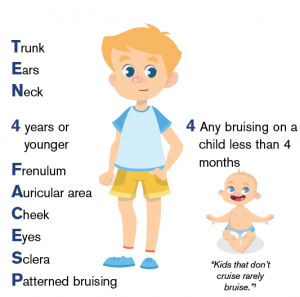Due to the COVID-19 pandemic, people have been staying home and spending more time with family. While this is usually a blessing, it may also be a stressor on families. There is growing concern that we may see a significant spike in suspected child abuse and nonaccidental trauma cases as a result. As emergency physicians, we must stay vigilant for signs of abuse and intervene when possible.
The TEN-4 FACES P mnemonic is helpful in keeping nonaccidental trauma at the forefront of our minds when evaluating and treating children for any and all complaints. Remember to evaluate areas of suspicion a “toddling” child would not normally injure on their own. Look for bruising that does not fit the story, petechiae as a sign of injury around the eyes and behind the ears, and patterned bruising from objects that may have been used to strike or punish a child.
Some emergency departments are fortunate to have specialists on call to assist in these situations. Make use of your local child abuse pediatrician or your forensic nursing team if available. These specialists can be a significant help in delving deeper into the family history and social stressors affecting a family and serve as a liaison with law enforcement and child protective services. If these options are not available to you, make sure you are familiar with your local child protective services and police procedures for reporting and handling these situations. Remember that as emergency physicians, we are mandated reporters of child abuse and neglect.
What may appear as a minor injury could be a sentinel event and, if caught early, has the potential to prevent further abuse and even a fatality. More than 27 percent of children seen in the emergency department for abusive head trauma had been seen previously for what was a suspected sentinel injury that may have been initially overlooked. This horrifying statistic should motivate us to make a real difference in the lives of these patients by staying alert for signs of abuse and report concerning cases early to child protective services.
Ms. Hinton is fourth-year medical student at University of Colorado School of Medicine in Aurora who is interested in emergency medicine. Dr. Trop is an attending physician in Colorado Springs, Colorado.
References
- Ten-4 bruising rule. Face It website. Accessed July 28, 2020,
- Pierce MC, Kaczor K, Aldridge S, et al. Bruising characteristics discriminating physical child abuse from accidental trauma. Pediatrics. 2009;125(1):67-74.
- Sheets LK, Leach ME, Koszewski IJ, et al. Sentinel injuries in infants evaluated for child physical abuse. Pediatrics. 2013;131(4):701-707.
Pages: 1 2 | Single Page






No Responses to “TEN-4 FACES P: A Mnemonic to Help You Spot Signs of Child Abuse”